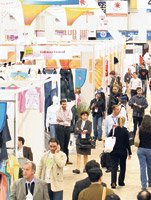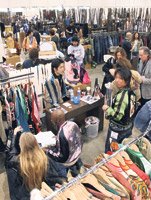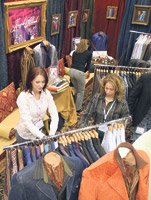Trading Up
Trade shows add amenities, get more selective, to stay competitive.
As the number of apparel trade shows continues to increase, retailers and manufacturers alike are having to make tough strategic decisions about which shows they want to spend the time and expense to display at or shop. As a result, trade shows have added perks to keep both buyers and exhibitors signed on—not the least of which is becoming even more scrupulous about offering the best selection of apparel possible. Granddaddy of them all With over 5,000 brands and more than 112,000 attendees, MAGIC International is the world’s largest fashion trade show. But even it is forced to constantly strive for improvement in all aspects of the show, says marketing director Camille Candella.
“We remain competitive because we focus on the customers.
We listen to them—and not just anecdotally—and consistently make genuine efforts to determine how we can improve the show.”
One of MAGIC’s newest innovations is the Buyer’s Suite, launched in February 2006. Not only is it a place for buyers to relax and eat during the busy show, but it is also staffed with retail experts in a range of market categories.
“It’s a place where they can come for expert advice on how to better shop the show,” says Candella, “and it all came about from feedback from the buyers.”
To gather such feedback, MAGIC employs a full-time retail relations team that works year-round making some 6,000 visits and 70,000 phone calls to retailers around the country to better learn what they need from the show.
And from the exhibitors’ side, “We talk to them to understand their business and the changes they foresee and what they are noticing in their market segment. We take all of this feedback into consideration and use it to make improvements in our show, re-merchandising and adding new market segments.”
The result is a show floor that has changed dramatically over the years, says Candella. “Our customers are shopping in different ways. Most significantly, they are shopping across additional market segments.”
And because the apparel industry changes faster than ever, “it is increasingly difficult for buyers to overview, analyze, and interpret trends on she show floor by themselves. As such, we have launched several new initiatives in key markets. These juried areas give our customers a great starting point for directional resources and allow them to see the brands in a lifestyledriven environment.”
These “neighborhoods” on the show floor include areas dedicated to contemporary streetwear; the premium and contemporary markets; better, bridge, and updated women’s markets; as well as a sourcing section for apparel contractors and fabric/trim manufacturers.
For the August 2006 show, further innovations include a new and improved Swim pavilion at the Las Vegas Hilton with ISAM, new accessories resources with a greater focus on contemporary offerings, a greater focus on men’s lifestyle offerings, re-merchandising in the youth markets, and a continued focus on new collectiondriven resources in women’s contemporary apparel.
MAGIC also touts its extensive roster of industry seminars held throughout the show. Says Candella, “We offer one of the most extensive educational services in the industry. No other show offers as many free industry seminars as MAGIC.”
Last but not least is MAGIC’s location, in Las Vegas, reason enough for many attendees to keep coming. And then there’s the opening night party, which draws top musical acts.
Location and selection As MAGIC attempts to offer everything under one roof, other shows tailor their offerings to a targeted audience.
The Los Angeles Fashion Market can draw a growing customer base without even trying, thanks to Los Angeles’ increasing prominence as a global fashion capital. “Los Angeles is where contemporary trends are starting, and it’s becoming more of a player on the international scene,” says Joanne Lee, services director for the California Market Center. Celebrities are all wearing items that can be found on our fifth floor.”
The CMC is part of a coalition of neighboring buildings in downtown Los Angeles known as The Intersection, which also includes The New Mart, Cooper Design Space, and Gerry Building. The CMC’s numbers are unparalleled anywhere in the country, Lee says: over 100,000 visitors per year shopping 10,000 product lines, and the building is open 365 days per year.
Designers & Agents, also a founding member along with the Los Angeles Fashion District Business Improvement District of The Intersection, is focused on the contemporary young designer market—“the market that’s having the most success,” says co-show director Ed Mandelbaum.
D&A (held for the past eight years in Los Angeles and the past four in New York and Tokyo) is also a juried show, meaning it is highly selective about what exhibitors it accepts—currently about 1 out of every 25 applicants.
Says Mandelbaum, “If you have great product, your show is focused on a market where stores are not closing but opening, and you get the best of that market and treat people nicely, then every time we do a show we have more exhibitors and more buyers.”
D&A is also content to remain a comparatively smallshow: The twice-yearly Los Angeles show, held at both The New Mart and Cooper Design Space, features about 275 booths and is at full capacity. “We’re not greedy,” says Mandelbaum. “We don’t put any effort into getting bigger, though of course we’d like to grow. With the L.A. show, we’ve arrived at how big we want to get, and now all we do is just try to fine tune it in every way to keep the show getting better and more interesting.” Though Designers & Agents advertises in Europe and has a Web site, “People know who we are and they call us,” says Mandelbaum. “We don’t call them.” Other shows are opening in underserved geographic regions. Trafik, which will present its fourth show this August, is held in Miami’s South Beach. Florida, according to show director James Costa, is the second-largest East Coast retail market after New York. “We saw a need for the Southeast to have something,” says Costa, adding that retailers have told him that “the money it costs to go to shows [outside the Southeast] begins to exceed the return they get.” For the August show, Trafik is expecting about 300 exhibiting brands and some 1,400 buyers. The emphasis is on new contemporary lines. “Buyers have to understand that they’re going to be able to find the new hot thing at our show, and I think we’re on track for achieving our goal in that aspect.” For the next show, Trafik will introduce a new emerging designers section called Transit, which will draw heavily on designers from Latin America. Trafik staff has undertaken scouting trips to Brazil, Argentina, and Mexico, meeting with some 40 brands that will be fresh to U.S. retailers. Says Costa, “Retailers will be able to get something at our show that they can’t get anywhere else.” Trafik is also a juried show, drawing on the expertise of its staff: Costa, for example, is the founder of Carpe Denim. “We feel we have the necessary tools to select the quality and aesthetic level that retailers are looking for,” he says. But for extra input, Trafik uses a group of five key retailers— “among the biggest in the nation,” says Costa—from all parts of the country to act as an advisory panel that not only helps identify hot brands, “but everything that would be accommodating to a buyer, we direct those questions to them.” And because they’re from different parts of the country, they give Trafik important geographic insight. “Geography is very important in retail,” says Costa. “What sells one place doesn’t necessarily sell somewhere else. A location outside Los Angeles, New York, and Las Vegas also benefits Dallas-based Fashion Industry Gallery, which has recently pulled retailers from Michigan and Illinois, much farther away than usual, says FIG acting director Elyse Wasserman. To help compensate for the time and cost of attending the markets, “We’re trying to make buyers’ stays as easy and fun as possible,” says Wasserman. Buyers can take a moment to relax and get a complimentary makeover or massage in the lobby. Three times per day free food is distributed by “FIGlets”—volunteer fashion students dressed in designers’ clothing. There’s also valet parking, a shuttle running to the Dallas Market Center (whose shows run concurrently), and discount rates at local boutique hotels. For exhibitors, all fixtures are provided, “so they don’t have to bring anything,” says Wasserman. FIG also makes it easy for exhibitors to leave by sending around a cart with shipping materials at the end of the show. Still, the amenities are all secondary: “The first thing is the quality of the product they’re going to find here.” Wasserman boasts of recently drawing premium-denim brand True Religion, plus Betsey Johnson, “whom we lured with [show-floor] location and thepromise of having great stores shopping at FIG.” And even a regional market like FIG is benefiting from selectivity. “We’re very picky about whom we let in,” says Wasserman. New exhibitors are screened for the quality of the line, what retail accounts they have, and what accounts they’re courting, she says. Atlanta-based America’s Mart is another show benefiting from its geographic location: 90 percent of its buyers are from the 10 Southeastern states. Offering kids’, bridal, and accessories sections in addition to men’s and women’s apparel, the show has nevertheless followed the selectivity trend as well. Premiere is a juried show-within-the-show focused on high-end contemporary apparel. The show has grown from twice per year to five times and entices buyers to keep coming with the usual amenities, plus seminars, fashion shows, and private concerts that have drawn the likes of Tom Jones and Tony Bennett. “Most successful stores are creating experiences when somebody comes into the store,” says senior vice president Lawton Hall, “so we want to create an experience here where it’s an event, not just buying a bunch of lines. We’re in show business.” Atlanta boasts plenty of conveniences, including 10,000 hotel rooms within walking distance of the market center and a rapid rail to airport. There’s also a new worldclass aquarium and of course that priceless Southern charm. “People say that folks are friendlier here and more helpful than other places they go,” says Hall. Targeted marketing Niche-driven shows such as Material World—which is focused on fabric, sourcing, and apparel technology—benefit from less direct competition than fashion-based trade shows. But that doesn’t mean they don’t have to constantly improve to keep attendance rising, says executive vice president Tim von Gal. “Trade shows have to serve the industry if they’re going to have viability, and because the industry evolves, shows must evolve as well.” To make sure it draws the most important exhibitors, Material World, which is held biannually in New York and Miami, has “unparalleled alliances” with various industry associations, including the American Apparel and Footwear Association, American Apparel Producers’ Network, and the Textile Distributors Association. “We stay in tune with the needs of their memberships to make sure our show is representative of their needs,” says von Gal. Material World puts special emphasis on seminars, drawing on partnerships with Cotton Inc., WGSN, and the AAFA, which produces a highly successful executive sourcing summit. For the future, expect Material World to develop an increasingly global perspective. Whether or not a market is a niche is really a matter of perspective, says Brian Pagel, group show director for the Imprinted Sportswear Show. Focused on heat transfers, screen-printing, embroidery, and retail—all around the theme of embellished apparel—ISS is “in some respects a niche, in others fairly broad-based.” ISS has increasingly played the role of matchmaker to address its customers’ needs. Exhibitors and buyers take advantage of the show’s extensive database to find each other. “There may be a screen-printer looking to go into embroidery, or a retailer looking to decorate in-house. So [the show] is about giving them the background they need to diversify their business,” says Pagel. ISS’s seminars also help “create buying communities that put buyers in front of sellers.”
























